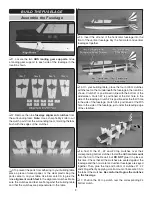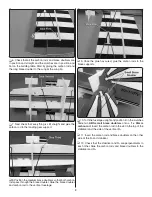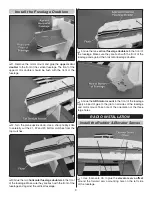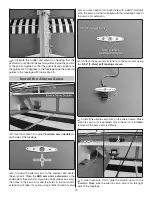
18
❏
5. Make sure all wires are clear of servo arms
and pushrods.
❏
6. Make sure all hinge tape is securely attached.
❏
7. Balance your propeller (and spare propellers).
❏
8. If you wish to photograph your model, do so
before your fi rst fl ight.
❏
9. Range check your radio when you get to the
fl ying fi eld.
FLYING
The Citabria 3D is an airplane suitable for both indoor and
outdoor fl ying. If you plan on fl ying outdoors, make sure that
you choose days with very light to calm winds (less than 5
mph). If this is your fi rst experience with an indoor-style foamie,
seek help from experienced modelers. Join a local fl ying club
or ask your local hobby dealer where the nearest approved
fl ying sites are in your area.
CAUTION
(THIS APPLIES TO ALL R/C AIRPLANES):
If, while fl ying, you notice an alarming or unusual sound
such as a low-pitched “buzz,” this may indicate control
surface
fl utter.
Flutter occurs when a control surface (such
as an aileron or elevator) or a fl ying surface (such as a
wing or stab) rapidly vibrates up and down (thus causing
the noise). In extreme cases, if not detected immediately,
fl utter can actually cause the control surface to detach
or the fl ying surface to fail, thus causing loss of control
followed by an impending crash. The best thing to do
when fl utter is detected is to slow the model
immediately
by reducing power, then land as soon as safely possible.
Identify which surface fl uttered. Make certain all pushrod
linkages are secure and free of play. If it fl uttered once,
under similar circumstances it will probably fl utter again
unless the problem is fi xed. Some things which can cause
fl utter are; Excessive hinge gap; Not mounting control
horns solidly; Excessive free play in servo gears; Insecure
servo mounting; and one of the most prevalent causes of
fl utter; Flying an over-powered model at excessive speeds.
Takeoff
The Citabria 3D can take off from a smooth surface (ROG)
or can be easily hand-launched. If you want to perform an
(ROG) takeoff, make sure the surface you are using is free
of holes that can fl ip the plane over or break the landing gear.
Rise-off-ground (ROG) takeoffs should be reserved for indoor
fl ying and should be performed with the model rolling away
from you and others. For the fi rst fl ight set the controls to low
rate. If for the fi rst fl ight the plane is to be hand-launched,
have an assistant hand launch it. This will allow you, the pilot,
to have both hands on the control sticks to make any fl ight
corrections if the plane is out of trim. Once the Citabria 3D
has been fl own and trimmed out, you will be able to hand
launch the plane easily by yourself. If you are fl ying outdoors,
always takeoff into the wind.
Flight
For reassurance and to keep an eye on other traffi c, it is a
good idea to have an assistant on the fl ight line with you. While
full throttle is usually desirable for takeoff, the Citabria 3D will
fl y great at ½ to ¼ throttle indoors.
Take it easy with the Citabria 3D for the fi rst few fl ights, gradually
getting acquainted with it as you gain confi dence. Adjust the
trims to maintain straight and level fl ight. After fl ying around
for a while, and while still at a safe altitude with plenty of
battery power remaining, practice slow fl ight and execute
practice landing approaches by reducing the throttle to see
how the model handles at slower speeds. Add power to
see how it climbs as well. Continue to fl y around, executing
various maneuvers such as gentle rolls, loops, stalls and
hammerheads, making mental notes (or having your assistant
write them down) of what trim or C.G. changes may be required
to fi ne tune the model so it fl ies the way you like. Mind your
battery power. It is best to have a timer set to alert you when
it is time to land.
Landing
To initiate a landing approach, lower the throttle while on the
downwind leg. Allow the nose of the model to pitch downward
to gradually bleed off altitude. Continue to lose altitude, but
maintain airspeed by keeping the nose down as you turn onto
the crosswind leg. You will notice that the plane bleeds off
speed very quickly if the nose is raised with power off. Make
your fi nal turn toward the landing area, keeping the nose down
to maintain airspeed and control. Level the attitude when the
model reaches the edge of the landing area, modulating the
throttle as necessary to maintain your glide path and airspeed.
If you are going to overshoot, smoothly advance the throttle
(always ready on the right rudder to counteract torque) and
climb out to make another attempt. When you’re ready to make
your landing fl are and the model is a foot or so off the deck,
smoothly increase up elevator. You may also have to blip the
throttle until it gently touches down.
One fi nal note about fl ying your model. Have a goal or fl ight
plan in mind for
every
fl ight. This can be learning a new
maneuver(s), improving a maneuver(s) you already know, or
learning how the model behaves in certain conditions (such as
on high or low rates). This is not necessarily to improve your
skills (
though it is never a bad idea!)
, but more importantly
so you do not surprise yourself by impulsively attempting a
maneuver and suddenly fi nding that you’ve run out of time,
altitude or airspeed. Every maneuver should be deliberate,
not impulsive. For example, if you’re going to do a loop, check
your altitude, remember to throttle back at the top, and make
certain you are on the desired rates (high/low rates). A fl ight
plan greatly reduces the chances of crashing your model just
because of poor planning and impulsive moves.
Remember
to think.
Have a ball! But always stay in control
and fl y in a safe manner.
GOOD LUCK AND GREAT FLYING!

















